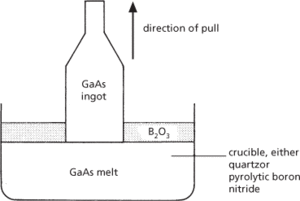A method of growing semiconductor crystals from molten form by slowly pulling the crystal vertically from the melt. A layer of liquid boric oxide (B2O3) is floated on the surface of the semiconductor to confine the melt – hence the description liquid-encapsulated. The growth is started using a seed crystal, which is introduced through the boric oxide when the appropriate temperature profile is achieved. The machines used to grow the crystals are referred to as crystal pullers. High-pressure LEC processes are performed under high external pressures – up to 50 atmospheres. Low-pressure LEC processes are carried out at pressures of about 1 atmosphere. The pullers required for each of these processes are different, and different heat-flow characteristics exist; the two types of growth machine are therefore not easily interchangeable. The diagram shows an example of gallium arsenide growth. The liquid encapsulation and high pressures originally used were required to contain the rather violent reactions that occur as the gallium and arsenic react exothermically to produce the gallium arsenide melt. The low-pressure technique was developed by introducing the arsenic in a controlled manner into the molten gallium below the boric oxide surface.

Schematic diagram of liquid-encapsulated Czochralski growth method
- Cassegrainian telescope
- Cassegrain telescope
- cassette
- Cassini
- Cassini Division
- Cassini, Giovanni Domenico
- Cassini, Giovanni Domenico (1625–1712)
- Cassini, Jacques (1677–1756)
- Cassini–Huygens
- CASSIOPE
- Cassiopeia
- Cassiopeia A
- Cassirer, Ernst (1874–1945)
- cassiterite
- cassowary
- cast
- Castalia
- caste
- castellanus
- Castilla, Ramón (1797–1867)
- casting out nines
- cast iron
- castle
- Castlecliffian
- Castle Hill Uprising (1804)